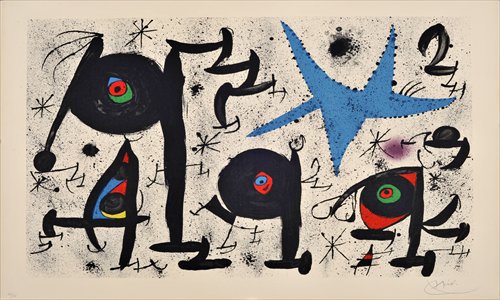
Tribute to Joan Prats
This is the second time that works by Joan Miró have been exhibited in Shanghai, after debuting here in 1995. Shi Zhecun, the late art critic and writer commented back then: "Some viewers whispered to each other at the show. They didn't say it was good, but they didn't dare say it wasn't good. And of course, they were afraid to say they didn't understand it. But it's true that they did not understand."
Abstract and childlike
Nearly two decades have passed since then, and works of surrealism are no longer new to Chinese audiences. However, at the Shanghai Art Museum, where The Illusion of Reality - 2012 Miró's Prints Exhibition is currently on show, there are still lots of viewers who find Miró's works to be simple, abstract and even childlike. Miró's works are rarely figurative, or representative of anything at all; as some people point out, they look like random strokes, sketches and splashes of color that anyone could do.
"The images in Miró's works are colorful and lively with peculiar shapes," said Fang Zengxian, director of the Shanghai Art Museum. "The works are the result of the artist combining his imagination and meditation … Miró's works are simple, but charming, as he deliberately returns purity and simplicity with relaxed, happy and humorous interests. It's hard to imagine that he actually led a difficult life marred by poverty."
As one of the most renowned Spanish artists, and among the best-known surrealistic artists of the 20th century, Miró is often spoken of alongside Salvador Dali and Pablo Picasso. Showcasing his striking colors and bold imagination, this exhibition is the biggest-ever showing of Miró's prints in China. More than 170 prints are on display spanning over 50 years of the artist's work at different stages and developments of his life.
"The works on show represent the classic Miró style," said Fang. "They maintain the freshness and keenness that children have, and possess the simple and rich colors that are both touching and lively."
There are many similar images and symbols appearing in Miró's works. However, the different combination of them convey different ideas to different audiences. Among the exhibits, Ubu the King is based on a play of the same name by the French playwright Alfred Jarry, and Miró has reproduced the absurdity of the play with a characteristic touch of humor.
The moon and stars
The series The Lizard with Gold Feathers is the name of a poem written by Miró, and the series of prints are illustrations for the poem. According to the museum's curatorial statement, Miró created a mysterious world in his lithographs with scenes from the artist's hometown in Catalonia as well as other depictions inspired by nature including the sun, the moon, stars and animals. Trace on Wall also reflects Catalonian history, customs and scenic spots. While in the series The Ring of Dawn, Miró painted a set of mini-prints.
In the series Tribute to Joan Prats, Miró painted strange creatures in the shapes of mammals, birds, reptiles and insects. All of these surrealistic elements are frequently seen in his prints, including numerous details that are unable to be deciphered.
"Miró's works arise people's admiration for the arts," a visitor surnamed Gao, who is an art teacher, told the Global Times. "His works make us aware that the nature of art comes from the bottom of your heart with simplicity."
Date: Until April 3, 9 am to 5 pm
Venue: Shanghai Art Museum
Address: 325 Nanjing Road West 南京西路325号
Admission: Free
Call 6327-2829 for details

Copyright ©1999-2011 Chinanews.com. All rights reserved.
Reproduction in whole or in part without permission is prohibited.